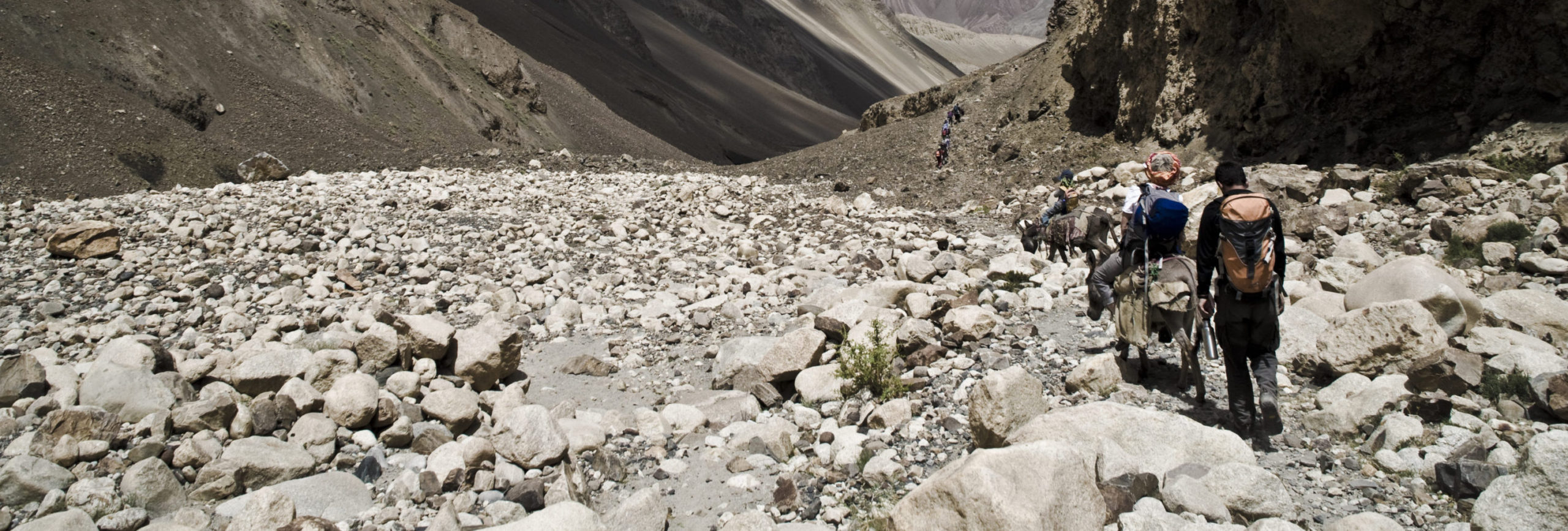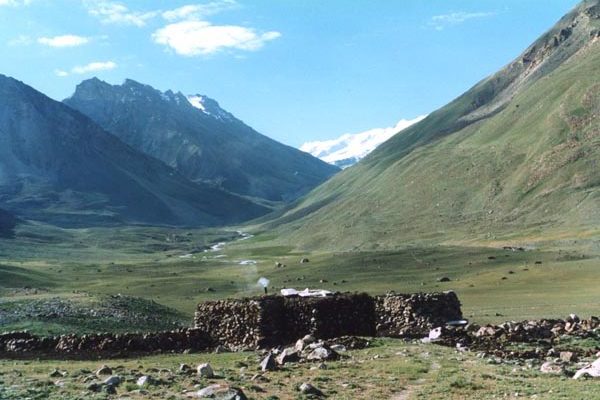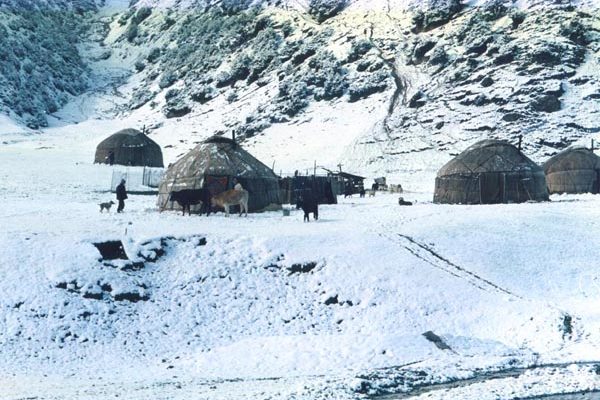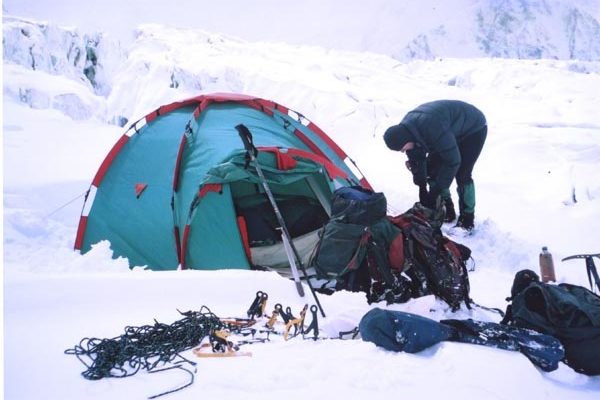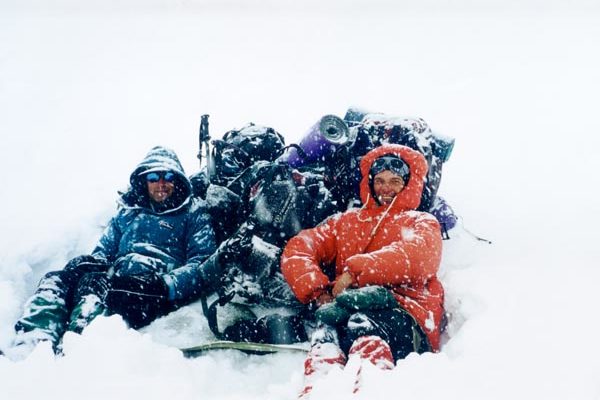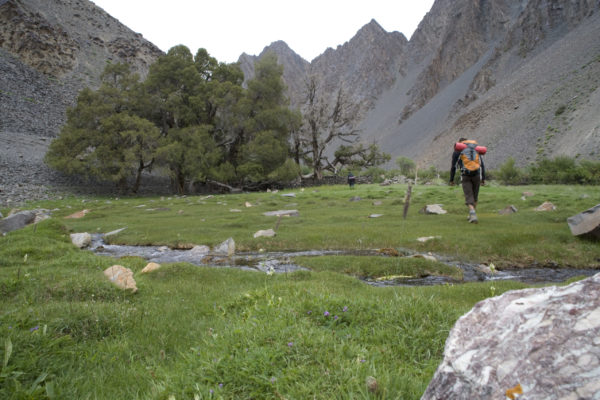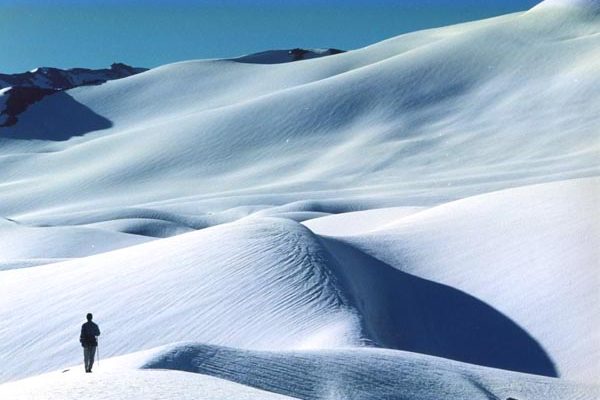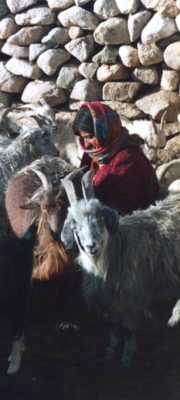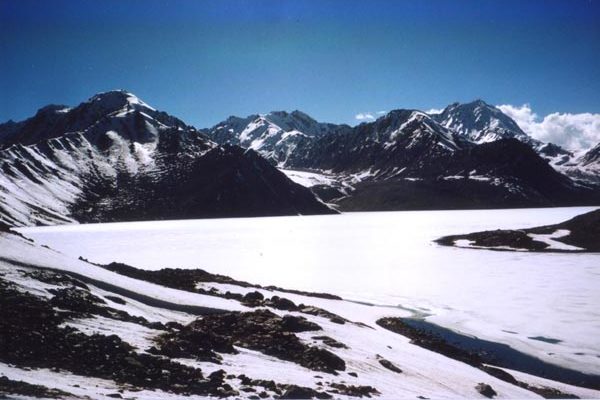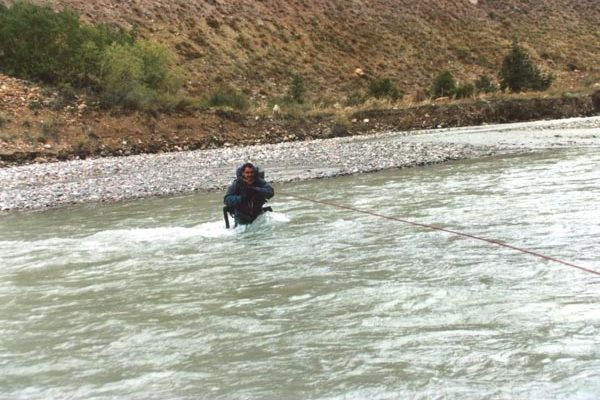The Pamir Mountains is a pristine trekker’s paradise. The variety of trips is vast and still a lot to explore. From relaxing one-day trips to adventurous three-weeks trekking including stream- and glacier-crossings.
Contribution by Peter Burgess
“Why would one wish to travel on foot in this uninhabited mountain region with its hazards of sudden blizzards, avalanches, rockfalls, crevasses, accidents, sunburn, frostbite and all forms of high-altitude illness?” The question was asked rhetorically by the Russian academic and mountaineer Vladimir Ratzek in 1980. Ratzek himself certainly knew the answers, which quickly become apparent to anybody who ventures out into the mountain fastness of the Pamirs.
The Pamir mountains of Tajikistan are, without doubt, the least visited mountain range in the world, yet one which offers some of the most magnificent landscapes, picturesque rural scenes, exhilarating trekking and genuine hospitality to be found anywhere on the planet. Summers, and thus the standard trekking season, are short, winters long; locally available supplies, transport and maps are limited; a lack of even the most elementary Russian or Tajik languages can leave the visitor floundering in frustration; the internal security regulations of the Vazorati Amniyat (the Ministry of Security, the Tajik successor to the Russian KGB), or the Russian and Tajik Border Forces (who patrol the external i.e. Tajik-Afghan and Tajik-Chinese borders) can prove to be the final insurmountable obstacle; but the rewards outstrip the time and energy invested in organising a trip on the Roof of the World.
Despite the lack of apparent interest shown by outsiders, the Tajik Pamirs have played host to a series of illustrious travellers and explorers, notably the famous Buddhist pilgrim-explorer Hsuan Tsang (c.640 AD) and Marco Polo, who describes passing through Ishkashim in c. 1271. The Pamirs lay astride the Silk Road, connecting China to what is now the Middle East, though the actual routeways meandered north and south of the Pamirs, through Ferghana and what is now the Wakhan Corridor of Afghanistan.
The real heroes, the true pioneers, are of course the Tajiks and Kyrgyz who settled the valleys and high pastures of the Pamirs and withstood the winters year in, year out, for centuries, irrigating the land with thread-like channels running many kilometres across rocky mountain slopes, subsisting off meagre grain harvests and their livestock, building their own houses and making their own clothes, occasionally trading with distant markets in Afghanistan, Kashgar, and Bukhara. These were communities that were truly isolated and dependent on their own ingenuity for their survival. Foreign exploration was focused largely on areas to the north, west and east of the Pamirs and it wasn’t until Anglo-Russian military rivalries forced the pace in the mid-nineteenth century that the Pamirs became the focus.
In January 1842, Lieutenant Wood of the British India Navy (of all things), having crossed the Afghan Hindu Kush from Kabul, arrived at the Pyanj River at Ishkashim and followed it up to Langar where he proclaimed the Pamir River to be the main feeder, and thus Lake Zorkul (at that time named Lake Victoria) the source of the Oxus / Amu Darya, and, subsequently, the southern extent of Russian Turkestan. In 1885 came Ney Elias on behalf of the British Government (armed with a personal letter of introduction from the Aga Khan – how we would wish for one of those now …); he travelled east across the Murghab plateau and surveyed several passes between the Bartang and Yazgulom valleys (where he is still remembered). In 1890 (the year after his Russian counterpart and rival Gromchevsky), Captain Younghusband more famously (in Western history at least) entered the Murghab plateau from the east, visited Alichur and Rangkul, before returning to what is now the upper Wakhan Corridor (Little Pamir) in 1891, from where he was unceremoniously ejected to British India by the Russian Colonel Yonov.
The Dane Olufsen visited the Pamirs (he referred to it as Mountain Boukhara) during his 1911 expedition and wrote extensively of Pamiri culture. Imperial Russian and Soviet expeditions took place but are recorded in Cyrillic. Gustav Krist, an Austrian fleeing east up the Alai Valley with the Kyrgyz ahead of the Soviet advance in 1923 wintered with his Kyrgyz hosts at Karakul Lake on the Murgab plateau at 4,000m. In 1947, Bill Tilman, having failed on his Mustagh Ata attempt with Eric Shipton, walked out down the entire length of the Wakhan Corridor on the Afghan side, wryly noting the convoys of Soviet trucks on the Tajik side.
In 1970 the French photo-journalists Roland and Sabrina Michaud travelled up the Afghan side of the Wakhan Corridor, recording their journey in their book “Caravans to Tartary”. Throughout the second half of the twentieth century, until 1990, there were numerous Soviet-led climbing expeditions to the high peaks of the Pamirs, focusing on Peaks Communism (7,495 m), Lenin (7,134 m), Korzhenevskiy (7,105 m) and Garmo (6,595 m). These involved large organised parties that were helicoptered straight in to permanent base camps.
When to go
Generalisations about seasonal climatic variation in the Pamirs are difficult; elevations increase dramatically from west to east and thus while the middle of the summer is the best season on the high-altitude Murghab plateau (3,800 m) in the east, the trekker is liable to be plagued by high humidity, hazy skies and raging flood waters in the sub-tropical valleys of Darwaz (1,200 m) in the west. Similarly, variations in precipitation dictate that around the Peak Communism massif in the central Pamirs, the glacier line is at around 2,800 m, while on the arid wind-swept Murghab plateau it is at around 5,000 m.
However, the most comfortable season for wilderness trekking in the Pamirs is July-September. Deep snow prevents the crossing of even the lowest mountain passes until late June, while after September serious winter equipment is needed and the Tajik and Kyrgyz shepherds, a glimpse into whose rugged lives is one of the highlights of any trip, have started to retreat from the high pastures. In these summer months, diurnal temperature ranges can be dramatic with daytime temperatures of over 30 degrees, and frost registered every night above 4,000 m. The mountains, always barren beyond the irrigated fields of the villages, can appear at their most desolate; yet in the upper valleys, beyond the final village and road-head, you will come across dazzling Alpine pastures, small niches for wild flowers, bees and butterflies. It is to these pastures that the shepherds head with their flocks of sheep and goats and herds of cattle and yak, the shepherds’ camps comprising dry-stone aylaqs in the case of the Tajiks, yurts in the case of the Kyrgyz (in Murghab district).
Beyond the final shepherds you will soon be into glacial moonscapes, where the river crossings are treacherous, and eventually the glaciers themselves. At this time of the year you can readily cross the high passes, most of which lie from 4,600 to 5,000 m, from one major valley to the next.
Autumn, running from late September to late November, affords the most picturesque landscapes as the skies are clearer, the rivers are running lower and turquoise blue, while the fields and orchards of the villages are a blaze of colour and harvest activity. Lower night-time temperatures must be contended with and the shepherds are leaving, but on the other hand the high passes are even freer of snow. Lower altitude trekking, village to village, is truly sublime at this time of year.
The first of the heavy snow fall usually hits Khorog in late December, but the higher villages in all the river valleys will be under snow one month before then. While the winter-wonderland scenery is truly majestic, winter trekking in the Pamirs is a serious business, with all but the lowest passes impossible. In 2001, Bulumkul meteorological station in Murghab district recorded minus 58 degrees, and if you are not adequately prepared you can expect frostbite. High-altitude sunshine is fierce, and the winds correspondingly so. Running water is hard to come by and you will need a stove not only for cooking food but also for melting snow. Perhaps the greatest impediment is not the cold temperatures, which can be mitigated, but the shortness of the days and the corresponding long nights. You will need to be in your 4-season sleeping bag from when the sun goes down at 17h00 to when it hits your tent at 09h00, and after several nights of this you will be all-too-familiar with the personal habits and histories of your companions.
Winter trekking
Spring, running from late March to June, is the least rewarding time for high-altitude trekking in the Pamirs. High valleys and passes are still clogged with snow, the mountains are frequently cloud covered, and the risk of avalanches and rockfalls is at its highest. Trekking at lower altitudes is enhanced as the village fruit orchards are in full blossom and the winter wheat is emerald green in the fields.
Organisation
IMPORTANT NOTICE ABOUT SAFETY: Large tracts of the Pamirs are uninhabited and, as in any mountain environment, weather and temperature are subject to sudden changes. This can result in avalanches, mudslides, flash floods, and damage to, or destruction or blockage of, pathways and bridges. Trekkers should act prudently at all times and ensure that they have adequate equipment, supplies and warm clothing. This article is intended as a general guide to trekking possibilities in the Pamirs and offers no guarantee of the safety of any particular route at any particular time.
Permission
Visas are required for travel to Tajikistan. For travellers from Western Europe, Japan and North America requiring one-month visas, a simplified procedure was adopted in 2003. For details see Visas.
In addition to a Tajik visa, a special permit is required to visit Gorno-Badakhshan (GBAO). See section on Visas.
If you wish to trek to Lake Sarez, you will need yet another permission (propusk), this time from the Committee for Emergency Situations and Civil Defence of the Government of Tajikistan, Lakhuti Str. 26, 734013 Dushanbe, tel: + 992 37 221 1331. Your letter can be addressed to Mr. M. Zokirov, Chairman of this Committee, and should indicate: full names and nationality of the persons and an explanation of the reasons for the visit. The application should be submitted at least ten days in advance of the date of intended travel. Expect the actual issuing procedure to take at least one full day. Without the propusk you will not be allowed to proceed beyond Barchadev, the last village before the lake on the approach from the Bartang Valley. Documents are checked in Barchadev village, and, for those trekking in from Murghab and Shughnan districts, at Usoi dam at the downstream end of the lake. The Tourism Information Office in Khorog may be able to help but will need considerable advance notice.
In addition, the Department of Tourism may request you to take (and pay for) one of their vehicles and driver/guides, but you can overcome this by providing them with the driver name and registration number of a private vehicle in which you intend to travel. The options for the 530 km from Dushanbe to Khorog are: a) a seat in a Russian jeep ; b) a seat in an overcrowded minibus (marshrutka – about ten seats); c) hire the whole vehicle (in which case you may prefer to pay a little more and take a Japanese 4×4). Jeeps and marshrutkas depart Dushanbe early in the morning from Avtobaza 2927, Ahmadi Donish Street, just before the airport – you would be advised to organise this the day before you wish to travel. The Tourism Information Office in Khorog can advise on current prices.
Once in GBAO, individual tourists should register with the “OVIR” in Khorog (N.B. avoid the “KGB”). If your GBAO permit mentions all border areas – see section on Visas – no further permissions should be necessary, unless you plan to go to Zorkul from the Khargush turn-off, for which permission from the Tajik border guards in Khorog is necessary.
Beware, however, of a so-called National Park Tax and a tax on what is vaguely defined as “mountain travel.” The legality of these charges is unclear but local officials will be happy to take your money. Moral: keep your distance from officials except when absolutely necessary.
Local Transport
From Khorog, there are now creaky and cheap bus services along the main valleys – down the Pyanj as far as the district centres of Rushan, Vanj and Kalai-khumb, and upstream to Lyangar, the highest village in Ishkashim district. Bus services also operate to Djelondy, the highest village in Shugnan district, and Sezhd, three-quarters of the way up the Shokhdara valley (Roshtkala district). To travel up the Bartang valley (Rushan district), Vanj valley, Murghab district, or any of the numerous smaller tributary valleys (almost all of which have roads in them) you will find marshrutkas in the bazaars or you can hire a jeep. There is also an increasing amount of private traffic (cars and trucks) along all the main roads in GBAO, and you will have very little trouble in hitch-hiking, at least when a vehicle finally comes along. Travel in the back of a 20-year old Russian truck is slow, cold and uncomfortable, but infinitely superior to the confines of a bus, or even a Toyota Landcruiser.
Supplies
Wherever you plan to go, remember that you are in one of the remotest, poorly supplied regions of the world, and you need to be absolutely independent. There is no formal accommodation in the villages of GBAO, apart from basic MSDSP/AKF guesthouses in the district centres. While in villages you can expect to be invited to stay at private houses (see A note on hospitality below), but most of the treks described above are higher than the villages. This means carrying tent, sleeping bag, stove (essential in winter, preferable at other times) and all your own food. You can get all the basic foods – bread, rice, lentils, tinned fish and meat, sausage, biscuits, chocolate, dried fruit, tea, coffee, sugar, milk powder – in Khorog bazaar, but you cannot depend on the other district centre bazaars. Quality dehydrated foods need to be brought in from outside. You will find ample pure spring water along the way (apart from in the frozen winter).
All other equipment – stoves, ropes, camera films, need to be brought in from outside. Low quality petrol and diesel can be bought in all district centres, but you need to bring in other fuels. In the summer, a tent is a matter of personal choice – the alternative is to sleep out (in which case you should probably still carry a bivvy bag) and in shepherds’ camps – but in the winter it is vital. Your clothing, sleeping bag and tent need to be the best that you can afford, 4-5 season and totally waterproof. If you are intending to go through the high passes or onto the glaciers you will need crampons, ropes, ice axes and trekking poles. Sun-block and good sunglasses are also vital and can make the difference between exhilaration and total misery.
Maps
The best map of the Pamirs is Markus Hauser’s “The Pamirs – a tourist map of Gorno-Badakhshan, Tajikistan, and background information on the region”, 1:500 000, distributed by Gekko Maps, Neuwiesenweg 1, CH-8132 Hinteregg, Switzerland; tel +41 44 980 6121, fax +41 44 980 6122; e-mail:info(at)geckomaps.com; website: https://www.geckomaps.com. This map also includes trekking routes and, on the back, interesting notes on the Pamirs.
Detailed Russian military maps (1:100,000 and 1:200,000) can be obtained from Kazibek, Almaty. The 1:1,450,000 map published in 1992 by the Cartographic Centre of the Uzbek Ministry of Defence gives a fairly good overview but lacks detail, although it contains most place names and shows the contours – it also requires knowledge of Cyrillic characters (obtainable at the bookshop on Rudaki street in Dushanbe). The 1:500,000 Tactical Pilot Charts available in the west (Stanfords in London) also give an overall idea, but despite their being a satellite map they are actually disappointingly inaccurate, and, due to the scale, also lack detail. There is also the limited-extent 1:200,000 map Pamir – Trans Alai Mountains, published by West Col Productions and Markus Hauser’s 1:100,000 map “Pik Lenin”, also distributed by Gecko Maps (see above). Both are available at Stanfords in London.
If you have any of these maps, be sure to keep them away from the prying eyes of the Russian Border Forces or “KGB” who will be happy to relieve you of them.
Guides
The concept of porters is unknown in the Tajik Pamirs, though you can hire donkeys and horses in the villages and shepherds’ camps. These are not cheap and you will be asked for at least $50 per animal per day, plus something for the donkey-man / horseman. People will be bemused if you ask for a guide, but will enthusiastically point the way. Every villager has tales of friends and relatives crossing the passes – to find someone who has actually done it is a far different proposition. While it is certainly the case that most of the passes provided route ways in former generations, the construction of roads in Soviet times, linking the valleys at their lower ends, meant the abandonment of such routes, and the loss of knowledge of their passage. Nowadays there are many good trekking English/French/German-speaking guides in the Pamirs.
See also the section tour operators and guides
A nice initiative regarding women’s guide in the Pamirs is: Women Rockin’ Pamirs
Contacts
For trekking in the Pamirs contact Odina Nurmamadov. Es is from the village Basid in the Bartang, e-mail here. Mobile phone +992 90 533 29 26
Another start-up company in the Bartang is Ibex Pamir Tourism (Avazbek Alifbekov) in Roshorv in the upper Bartang valley – see here.
For trekking and horse trekking in and around the most beautiful villages of the Pamirs see here and here. Aslisho Qurboniev, the operator, is one of the most remarkable self-starters in Pamirs tourism. Contact:
+992935661504 (Tj)
+7403741946 (UK)
Email: here or here.
For rock-climbing and mountaineering contact Anatoliy Sharipov mobile phone: tel +992 93 453 5909, Email here.
Muhofiz offers trekking in Khirmanjo village Khatlon district (on your way from Dushanbe to the Pamirs) and in Alichur (Murghab district) – see here and here.
If you want to stay in a hunting camp with a hot spring in one of the most remote corners of the Pamirs (Jarty Gumbez) and see Marco Polo sheep, get in touch with
Atobek Bekmurodov
+992 372 21 17 43
or
Tolibek Gulbekov
66 Lenin Street Murghab
Tel +992 3554 21 639
Also in Dushanbe:
Dekhoti Street 21/3 Apartment 33
Tel +992 372 34 06 20
Hospitality
Pamiri hospitality is legendary, and you will undoubtedly meet with it along the way, whether in villages or shepherds’ camps. Interaction with local people is always one of the most rewarding and memorable experiences of a visit in the Pamirs, and you will doubtless be entertained by raw musical performances in the museums that are Pamiri houses or Kyrgyz yurts. However, it is easy for such hospitality, especially in the economic conditions of Tajikistan, to be abused. You will be offered the same food to eat as that eaten by the poverty-stricken people of the settlements in which you are staying – that means bread, salt-tea, dairy products, meat which unless freshly slaughtered is likely to be somewhat dubious, and, either fresh or dried fruits (apricots, mulberry). If you accept the hospitality, you will be obliged to eat the food. If you produce your own food, you should be prepared to share it around, and it won’t go very far in a household of over 10 people. If you are more than 2 people it is in any case unfair to accept the hospitality of food-deficit families. Gifts, preferably cash, will be refused at first but accepted eventually, and you should persevere. The amount is up to you, you soon learn to gauge it, but we suggest $15 per night and person. We recommend to hand over the money to the housewife. If even she would not accept it, put it somwhere with a note under a pillow. Fruits and other gifts (pocketknife, sewing kit, brouchure from the home country, etc.) can be offered.
If you supplement this by taking photographs of the family, and honouring your promise to forward the prints, the host family will be delighted. Remember that you may not be near a settlement at night. Furthermore, the limited space and means of shepherds’ camps, and the eye-stinging smoke of the aylaq, may mean you have to (or prefer) to sleep outside anyway.
Trekking Suggestions
Trekking in the Tajik Pamirs is about as difficult as it gets. You need to be well-equipped and fully independent in terms of supplies. The terrain is tough, and there are no tea-shops or lodges along the way. Once you are above the shepherds’ camps you are on your own, and paths are often non-existent. Note the permissions required, as described in the Organisation section above. On the other hand, all the treks outlined below offer stunning scenery, are highly enjoyable and manageable with a minimum of technical equipment and expertise. They have been graded 1-5 in terms of physical (non-technical) difficulty.
We recommend the Jan Bakker’s trekking guide: Trekking in Tajikistan
Eastern Pamir
The Eastern Pamir, the true Pamir – the Bam-i-Dunya – the Roof of the World – comprises Murghab district and the upper reaches of the Pamir River in Ishkashim district. The lowest point of this area (3,000 m) is where the Pamir River begins its steep descent to its confluence with the Wakhan at Lyangar, but the lowest point of Murghab district itself is over 3,500 m on the Murghab River downstream (west) of Murghab town. The Khorog-Osh highway crosses 3 passes in Murghab district – the Koitezak (4,273 m), the Ak-Baital (4,655 m) and the Kizyl-Art (4,336 m). Landscapes are wide-open and awesome but barren, almost lunar, the only vegetation being the summer pastures that stretch ribbon-like along the main rivers – Aksu / Murghab, Alichur, and Pamir – and higher streams, and isolated patches of tersken that provide fuel for the Kyrgyz inhabitants of the plateau. It is in the distant reaches of the Murghab valleys that you are likely to see Marco Polo sheep, ibex, and if you are truly fortunate, snow leopard.
Trekking in Murghab district is not to be undertaken lightly due to the high altitudes, waterless expanses, deceptive distances and the very real possibility of getting lost. Wind and cold, sun and snow glare, are pervasive while altitude sickness can be debilitating; writing of British Indian agents in the (Afghan) Pamir in 1869, Captain Montgomery of the Great Trigonometrical Survey wrote “…the intenseness of the cold was extreme whenever the wind blew, and they then felt as if they were going to lose their extremities, the glare from the snow was very trying to the eyes, all suffering from snow-blindness; their breath froze on their moustaches, and everyone moreover had to walk in order to keep some warmth in the body…”.
Nowadays, however, you don’t need to start walking at any of the main roads – your jeep can go cross-country for many miles at almost any point in Murghab; the jeep tracks you follow will invariably lead you to a Kyrgyz shepherds’ camp. Indeed many of the routes outlined below can be travelled without even leaving your jeep. Note that while Tajik shepherds generally visit the same aylaq year in, year out (and even if they do not, their stone dwellings remain in place and can be used as shelter) the Kyrgyz are more nomadic, and move their yurt encampments more frequently.
1. The Alichur Valley
The Alichur Valley is the jewel of Murghab district, dotted with yurt encampments throughout the summer. The valley runs in an east-west direction for approximately 65 kms and is bounded at its western end by Yashilkul Lake. The main Khorog-Osh road runs through the valley, entering it at Alichur village. At its widest the valley is approximately 8 km. Numerous side-valleys run north and south from the main valley, and most of these are jeepable for the first several km. Of particular interest is Bash-Gumbez, the road to which is 28 km east of Alichur village. From Bash-Gumbez village you can walk east, south or west into the Yuzhny Alichurskiy (Southern Alichur) range; the route south-east will bring you to Uchkul Lake (one day, grade 2), while the route south will lead you over the Bash-Gumbaz pass (4,720 m) to Zorkul Lake (two days, grade 3) at the head of the Pamir River, the Afghan border. Note that Zorkul lies within the restricted border zone, and to visit it you must gain prior permission from the Russian Border Forces in Khorog.
11 km east of Alichur village you can head north up the Bazaar-dara valley, and drive almost to the foot of a pass at 4,664 m. In certain years you may even be able to drive over the pass and continue on down the other side. From the foot of the pass on the far side you can climb Peak Alichur (5,803 m) in one very long day (grade 5). Otherwise, continue down, following the broken road to the confluence with another stream (14 km) coming in from the left (also confusingly called Bazaar-dara) – about 5 km up this valley you will find the ruins of the ancient stone settlement of Bazaar-dara (grade 1). From the confluence you can continue downstream (north) on paths to the confluence with the Murghab River (grade 3, see Murghab/Aksu Valley below).
From Alichur village you can walk down the Alichur River, off-road (the road here swings away south to the Koitezak Pass) 26 km to the eastern shore of Lake Yashilkul (3,720 m, grade 2). The Alichur river here meanders stunningly through its valley. Just before Yashilkul, on the right side of the river, there is a hot spring and some very broken Chinese tombs. At this point you can cross the Alichur River and head south to the dust-blown village of Bulunkul (10 km, grade 2) and thence a further 18 km down a road to the Khorog-Osh road. Alternatively, you can continue walking along the north shore of Yashilkul, following a clear trail, across the Big and Small Marjenai valleys to the downstream end of the lake, over a pass at 3,920 m and on downstream (now the Ghunt, the main river of upper Shugnan district) to the confluence with the Lyangar River at the Lyangar aylaq (2 relaxed days, grade 2). At this point you can turn north and take up one of the treks to Lake Sarez (see Central Pamir, below), or continue down to the main Khorog road beyond the village of Bachor (2 days, grade 3).
2. Murghab/Aksu Valley
Murghab town bestrides the Murghab River at an altitude of 3,650 m. Younghusband visited it in 1890 and wrote “It is a dreary, desolate spot… with a certain amount of grassy pasture and a few scrubby bushes by the river, but surrounded by barren hills, and bitterly cold. How these Tajik boder guards can support existence there is a marvel…shut up in dreary quarters, with nothing whatever to do – week after week, month after month passing by in dull monotony….” Over a century later, nothing much has changed.
Downstream, the Murghab River flows west, meandering delightfully, as the main feeder of Lake Sarez – you can drive the dirt road 37 km to the final semi-permanent settlements of Madyan, beyond which you can walk (2 days, involving crossing the Murghab River) to the confluence with the Bazaar-dara stream and south to Bazaar-dara, grade 4. 30 km downstream from Murghab you can cross a bridge and head up the tributary Yelisu River to the hot springs at Issyk-Bulok (4 km). From Issyk-Bulok you can continue to trek south for a full day into the head of the valley.
Upstream from Murghab, the river is known as Aksu, and passes through one of the widest, flattest sections of the plateau. The only way to travel through here is by jeep. On a clear morning in Murghab town you can see Mustagh Ata, (7,546m) in China, but it is 110 km away in a direct line. The road up the Aksu valley, however, is dramatic, passing through the settlement of Tokhtomush to Shaimak (106 km) at 3,840 m. The main road continues for a few more km to a hot spring. This is High Asia at its most exhilarating – you have the tip of the Wakhan Corridor in front of you, China to your left.
From Tokhtomush a road heads south-west 40 km to the tiny isolated shepherds’ settlement of Chech-Tebe, but you will need a guide, even if you are driving. From Chech-Tebe you can continue south-west to the hunters’ camp and hot spring at Djarty-Gumbaz (30 km), again, visited by Younghusband in 1890, past Kok-Djigut Lake to the eastern shore of Zorkul Lake (another 34 km), but again you will need a guide and, for Zorkul, permission from the Tajik Border Forces in Khorog.
3. Zorkul Lake
In 1842, Lieutenant Wood of the British India Navy explored the Pyanj and Pamir rivers as far as the latter’s source in Zorkul (the true source is actually the glaciers at the head of the Kara-Jilgasu River in the mountains to the south of Zorkul. To visit Zorkul you must get prior permission from the Tajik Border Forces in Khorog. From Ishkashim, you can drive up the northern side of the Wakhan Corridor to the final village, Lyangar (105 km), then continue up the Pamir River a further 46 km to the Tajik Border Forces check-post at Khargushe. Once through here, it is a further 40 km to the Tajik aylaq of Bash-Gumbez, and a further 4 km to the western shore of Zorkul (4,130 m). If you cannot pass through the Khargushe checkpost you must turn north and drive 32 km over the Khargushe Pass (4,344 m) to the Khorog-Osh road just south of Bulumkul.
The north side of Zorkul is full of Tajik shepherds in the summer; from the aylaq at Bash-Gumbaz you can trek north (2 days) to the Bash-Gumbaz in Alichur valley (see Alichur Valley above). Zorkul itself is 20 km long – the road runs along its northern shore and you can continue to Djarty-Gumbaz, Chech-Tebe and Murghab (see Murghab/Aksu Valley above).
4. Koitezak Pass
The Koitezak Pass is long and wide, with its highest point at 4,273 m on the Khorog-Osh road, 144 km from Khorog. Days can be spent exploring the side valleys and lakes to the north and south of the main road, and you will come across several Tajik aylaqs (grades 2-4). Peak Kizyl-Dong (5,704 m), standing proud to the south of the main road, is a steep climb for which you will need crampons. Allow 2 days (grade 5).
Central Pamir
The Central Pamir comprises the whole of Shugnan, Roshtkala and Rushan districts (including the Bartang valley), and Ishkashim district downstream of the confluence of the Pamir and Wakhan Rivers. Roads allow access along all the main valleys, and to an extent up many of the tributary side valleys. There are numerous side valleys in these districts, many of which have challenging, but manageable, passes at their heads. You have a good chance of seeing ibex around these high passes. The delight of trekking in these districts is in crossing from one main valley to the next, as this involves being off-road and away from the highest villages. The upper side valleys are studded with rich pastures and glacial lakes, and dominated by ice-peaks at their heads. You will pass Tajik aylaqs on both side of the passes, passes which themselves will frequently be ice-clad.
1. Roshtkala district to Ishkashim district
Roshtkala district encompasses the whole of the Shokhdara Valley which flows predominantly north-west to its confluence with the Ghunt at Khorog. Shokhdara is one of the prettiest, more intimate valleys of GBAO, with almost constant settlement and cultivation on both sides of the road for the first 60 km. The treks outlined below involve crossing the Wakhan Range.
From Khidorjiv (12 km from Khorog) you can trek south over a 4,380 m pass and down to Nishursp on the Pyanj River, 27 km from Khorog (grade 2). Allow 2 days, overnighting on the Shokhdara side. From the pass you can see Lake Sheva, 18 km away in Afghanistan. You can do a similar trek from Tussyan (16 km from Khorog), following the valley upstream before climbing the western slopes beyond the first of the major aylaqs that you come to.
From Vezdara (40 km from Khorog) you can trek south-west over a glacier and snow-covered pass at 4,870 m and steeply down into the upper Garm-Chashma valley of Ishkashim district (grade 4). Allow 2-3 days for the walk all the way to Garm-Chashma where you are rewarded with a hot spring. From Garm-Chashma it is 6 km down to Andarob on the Pyanj River, and a further 37 km downstream to Khorog.
From Budum-dara (43 km from Khorog) you can trek south and west, again into the upper reaches of Garm-Chashma valley (grade 4). From the Budum-dara turn-off it is about 13 km to the semi-permanent hamlet of Budum-dara. Another 3 km brings you to the Darmaidovan stream coming in from the west – follow this to its glacial head , and over the steep slopes (avoiding the ice) to Garm-Chasma-dara. Allow 3 days for the full walk to Garm-Chashma. This walk is actually easier from the Garm-Chashma side.
Alternatively, you can continue straight south up Budum-dara almost to the head of the valley, up to the obvious looking pass at 4,940 m, and pick your way carefully down to the upper reaches of Darshai-dara (Ishkashim district). This is a difficult trek (grade 5). From Budum-dara to Darshai-dara allow at least 2 days. Down at the Darshai-dara River you can head upstream an hour or so to the wide open pastures of Budum and Tung, full of shepherds in the summer, and the approaches to Peak Mayakovskiy (6,095 m) – you could spend 3 or 4 days exploring the valleys and glaciers up here. From Budum it is 2 days down a clear path to the village of Darshai on the Pyanj River, 36 km upstream from Ishkashim town. If you don’t fancy the Darshai-dara pass, you could hike the Darshai-dara from the village of Darshai to the pastures and aylaqs of Budum and Tung, and return the same way (grade 3).
From the village of Rubot (98 km from Khorog) you can trek south up the Vrang valley, over the ice-bound Vrang Pass at 5,070 m and down the long steep Vnukut valley to Vrang on the Pyanj River, 77 km upstream from Ishkashim town (grade 5). Allow at least 3 days for this walk. You emerge onto a magnificent stretch of the Wakhan corridor – look out for the Buddhist (Zoroastrian?) temple on the descent into Vrang village. 9 km downstream from Vrang, at the village of Torkh-Goz, you can climb back up the slopes one steep hour past the village of Yamchun, to a fortress with commanding views up and down Wakhan, and the exquisite Bibi-Fotima hot spring.
Jawshangoz, at 3,580 m, is the final village in Roshtkala district, 110 km from Khorog. The upper Shokhdara valley here is flat and wide, approaching the high Pamirs slightly further to the east. From Jawshangoz the road continues straight east for 11 km, affording magnificent views up side valleys to the south, of Peaks Karl Marx (6,723 m) and Engels (6,507 m).
All the valleys to the south of Jawshangoz can be explored (grades 2-4); if you want to get through to Ishkashim district, the best way is to proceed from Jawshangoz to the head of the valley and at the point where the road swings north towards Djelondy head south instead, then east, over the 4,432 m Mats Pass, and follow the good trail down to the Pamir River and the road, 121 km upstream from Ishkashim town (grade 4). From Jawshangoz to the Pamir River you should allow at least 2 days. There is now reputed to be a road up to the Mats Pass.
2. Roshtkala district to Shugnan district
The treks outlined below involve crossing the Shugnan range.
From the village of Nimoth (89 km from Khorog) trek north 25 km to the head of the valley, over the ridge-pass at 4,860 m, and down the glacier into the upper Rivak-dara valley. This is a tough pass (grade 5); the long walk out past Rivak Lake brings you eventually to Rivak village on the Ghunt River, 30 km upstream from Khorog. Allow 3-4 days for this trek.
101 km from Khorog, the Shokhdara road makes a large detour north to cross the Soktosh stream before resuming its eastward course towards Jawshangoz. At the Soktosh stream you can continue north and east along a side road that after 24 km brings you to the western shore of Lake Turumtaikul (4,200 m). From Turumtaikul you can trek back south in less than one day to Jawshangoz (grade 2), or continue along the southern shore of the lake 12 km to the Jawshangoz-Djelondy road at the Mysara Pass (grade 2). 15 km up the Soktash road, at the big turn east towards Turumtaikul, you can head steeply north 4 km up a side stream over the 4,400 m Duzakh-dara pass and continue on 19 km downstream to the village of Duzakh on the Ghunt river, 100 km upstream from Khorog (grade 4). At the first major confluence downstream from the pass, detour upstream 3 km to the picturesque Kulin lakes and views north to Peak Skalitskiy (5,707 m). Allow 2-3 days for this trek, which is more comfortably done coming the other way.
At the head of the Shokhdara Valley beyond Jawshangoz the road swings north and over the Mysara Pass (4,230 m) to Djelondy (45 km from Jawshangoz) on the Khorog-Osh road. At the Mysara Pass you can detour left a few km to view Lake Turumtaikul.
3. Shugnan district to Bartang Valley (Rushan district)
The treks outlined below involve crossing the Rushan range, from the Ghunt Valley to the Bartang. The best routes to Lake Sarez are through here, passing lakes, aylaqs and glaciers, with a choice of passes, traversing some of the most magnificent scenery in the Pamirs.
From the village of Chtam (62 km from Khorog), the route climbs steeply uphill to the Chtam Pass at 4,859 m. From the precipitous pass it is a steep drop down ice and snow to the glaciers at the head of the Shuvdara valley. Once off the pass it is a long walk out (15 km) to the confluence with the Ravmed-dara valley, and another 9 km downstream to the village of Khidjiz in the Bartang valley. Allow 3 days for this trek (grade 5). From the confluence of the Shuvdara and Ravmed-dara valleys you can detour up the Ravmed-dara, 6 km to the village of Ravmed, and 17 km more to the ampitheatre of glaciers at the head of the valley. From Khidjiz, it is 27 km to the Pyanj in Rushan district and a further 55 km upstream to Khorog.
Zarushkul Lake
The Western Pamir comprises Vanj and Darwaz districts, and can be said to extend northwards into the Ob-i-Khingou and Karategin (Rasht) valleys. The heads of the Vanj and Ob-i-Khingou valleys culminate in the Peak Somoni (formerly Peak Communism) massif (7,495 m). While the valleys are lower than those of the Central and Eastern Pamir, the passes are as high and the trekking, if anything, more arduous. The Western Pamir is wetter than the mountains further east, and as a result the glacier line is considerably lower, reaching down to 2,800 m. There is considerably more vegetation than at equivalent altitudes further east, and while you may still see the occasional ibex in the passes, you are just as likely to see bears lower down. Most of the treks in this region encompass technical glacial traverses, and this section therefore describes only one, which is manageable with a minimum of technical expertise and equipment.
Western Pamir
The Western Pamir comprises Vanj and Darwaz districts, and can be said to extend northwards into the Ob-i-Khingou and Karategin (Rasht) valleys. The heads of the Vanj and Ob-i-Khingou valleys culminate in the Peak Somoni (formerly Peak Communism) massif (7,495 m). While the valleys are lower than those of the Central and Eastern Pamir, the passes are as high and the trekking, if anything, more arduous. The Western Pamir is wetter than the mountains further east, and as a result the glacier line is considerably lower, reaching down to 2,800 m. There is considerably more vegetation than at equivalent altitudes further east, and while you may still see the occasional ibex in the passes, you are just as likely to see bears lower down. Most of the treks in this region encompass technical glacial traverses, and this section therefore describes only one, which is manageable with a minimum of technical expertise and equipment.
Chtam Pass (Photo Jonathan Renouf)
At the village of Shazud (94 km from Khorog), the main Khorog-Osh road leaves the Ghunt valley and begins the climb to Jelondy. At this point, a side road crosses the Ghunt to the true right bank and progresses upstream 22 km to the village of Bachor. The treks to Sarez begin at Bachor. 4 km upstream from Bachor you come to the confluence of the Ghunt and the Andaravaj rivers, the latter flowing down from Zarushkul Lake. Trek north along the Andaravaj River to the pass at 4,587 m, from which you look down and across to Zarushkul Lake with its magnificent backdrop of ice peaks. You then descend past a string of ribbon lakes to Vikhinj, an aylaq settlement one full day’s walk above Lake Sarez. Allow 3 days from Bachor to Vikhinj (grade 4). As an alternative (grade 4), from Bachor you can pass Andaravaj-dara and proceed further up the Ghunt to the aylaq at Langar, just below the Yashilkul dam. This puts an extra 12 km on to the trek. At Langar, turn north into the Langar valley, and follow an alternative route to Vikhinj. The main route crosses the Langar-Kutal pass at 4,629 m after 20 km, and then descends to Vikhinj via the three lakes of Uchkul / Kulin. As an alternative to the Langar-Kutal pass, follow the Chapdara valley past the sublime Chapdara Lake, rejoining the main route above Uchkul / Kulin. Yet another alternative is to descend the Ghunt from Yashilkul, and pick up the route at Langar (see Alichur Valley above). From the pastures above Uchkul/Kulin it is possible to detour north-east over a low pass and down to the Ramayiv lakes.
For more information on trekking in and around Bachor see here.
Trekking in the Bartang Valley (Photo Jonathan Renouf)
Vanj Valley to Yazgulom Valley
Note that this trek should only be attempted in the autumn when the water levels are at their lowest in the Yazgulom River (grade 5 because of the river crossing, otherwise grade 4). The trek starts at the village of Langar in the Vanj Valley, 35 km above the district centre of Vanj, which is in turn 170 km from Khorog. From Langar a disused and broken mining road leads up the Langar-dara valley to the south-east. This road actually continues half-way up the Langar glacier to a disused quartz mine on the glacier’s true right side. From the glacier you can look back across the head of the Vanj valley for one of the few views you can get anywhere in the Pamirs of Peak Somoni (7,495 m). An easy ascent up the true left side of the glacier gets you to the Langar Pass at 4,418 m from where you drop down into the Gujovasi valley, and on to its confluence with the Yazgulom. From Langar allow 3-4 days to this point. Head downstream the Yazgulom River looking for a suitable crossing point to the true left bank – this is the most dangerous part of the trek and you’ll need a rope. Be prepared to get wet. Ahead you’ll see the fields of the hamlet of Ubagn on the left bank.
From Ubagn there is a clear trail 24 km down the valley to Djamak, the road-head. From Djamak it is 20 km down the pretty Yazgulom valley to its confluence with the Pyanj, and from there a further 134 km upstream to Khorog.
TREKKING LINKS
Jan Bakker’s excellent blog with very good visual material: https://www.trekkinginthepamirs.com/
Panj river, Shakhdara and eastern Vanch: https://ai.stanford.edu/~latombe/mountain/photo/tajikistan-09/tajikistan-2009.htm
